#12 names of ganesha
Text
The 12 Main Names of Lord Ganesh and Their Meaning
Hinduism’s most popular elephant-headed god is Lord Ganesh. He is revered by millions of people all over the world. And is known for removing obstacles. We explore the rich meanings and fascinating tales. These tales are associated with Lord Ganesh’s twelve primary names in this instructive investigation.
Each name has a special meaning. The names represents a different aspect of his celestial identity. Join us as we explore the compelling legends behind these names. Whether you are a devotee or simply interested in Hindu mythology.
Revealing Lord Ganesh’s 12 primary names
Ganesha
Ganesha is whose name is derived from the words “gana” (group) and “isha” (Lord Shiva). It represents the civilised head of humanity. His benefits include wisdom and leadership abilities. This is because he is the son of Lord Shiva and Maa Parvati.
Vighneshvara
The name Vighneshvara means “Remover of Obstacles. It is a reflection of Lord Ganesh’s kindness and capacity for problem-solving. To overcome obstacles and hardships seekers ask for his help.
Vinayaka
Vinayaka is a perfect example of Lord Ganesh’s role. Lord Ganesha is known for leading and guarding his loyal followers. Since he is the “Supreme Leader” of Shiva’s followers.
Gajanana
Gajanana represents power and riches. And it represents an elephant face. Like the elephant he stands for strength and knowledge.
Lambodara
The term “lambodara” refers to a huge and round stomach. It represents Lord Ganesh character. He has immense potential for comprehending and assimilating all knowledge.
Ekadanta
Ekadanta means “One-Tusked”. Lord Ganesha had one tooth. It represents his ingenuity and wisdom. And the giving up of his tusk helped him to write the Mahabharata.
Heramba
Heramba is also known as “Protector of the Weak”. It is a representation of Lord Ganesh’s protective and kind attitude.
Gauriputra
As the “Beloved Son of Goddess Gauri” , Gauri is Goddess Parvati. Gauriputra symbolises the strong link between a mother and child. It stands for unwavering love and defence.
Sumukha
Lord Ganesh’s bright and contented look is highlighted by Sumukha. In her description of his lovely face she encouraging us to discover our own inner beauty.
Dhumravarna
The name “Dhumravarna” refers to his smoke-colored skin. He denotes Lord Ganesh’s link to sacred ash. Also serves as a reminder of the transience of existence.
Read the full article on Stories of God website article 12 names of Lord Ganesha
Ganesh’s twelve primary names shed light on his significant impact on Hinduism and everyday life. Lord Ganesh’s titles represent the many duties and qualities he plays, from clearing obstructions to strengthening the weak.
We learn more about his heavenly nature as we investigate these names, arousing adoration and devotion. Lord Ganesh’s names continue to be a tribute to his ubiquitous protection and guidance, just as followers seek his blessings.
0 notes
Text
Searching for the reference (12)
Something a bit different from my usual reference searches - not fairytales, not folklore, but the Hindu religion and mythology. in “Fairest - The Return of the Maharajah”, a group of Hindu deities appear in a dream.

I could identify several of them. Rama is explicitely named in the comic. Ganesha is here on the left, the goddess is Manasa, from a brief check I think the white cow is Kamadhenu... But one of the deities is unknown to me: the elder man with a long white beard, right next to Ganesh. If somebody knows who he is, don’t hesitate to let me know!
12 notes
·
View notes
Photo
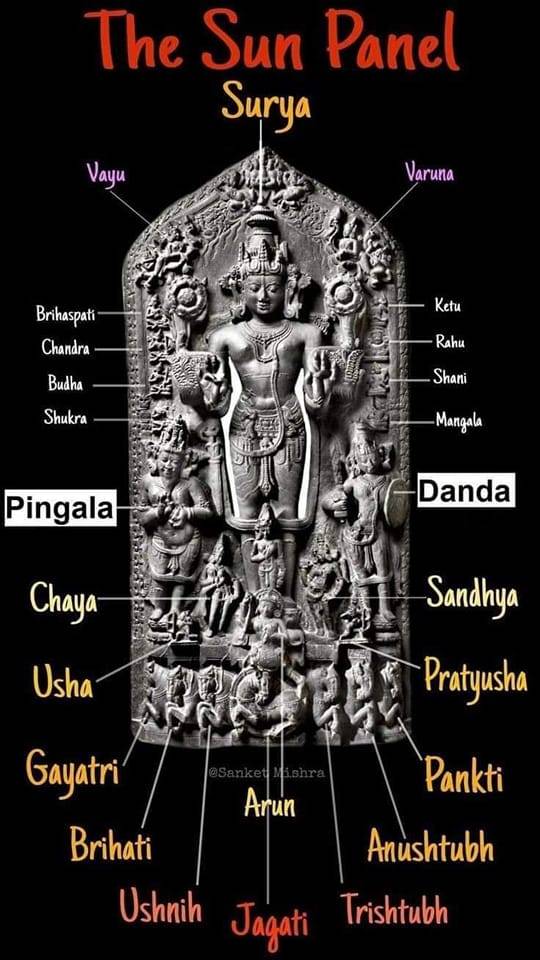
~ “SEVEN HORSES OF SUN GOD
The seven horses are named after the seven meters of Sanskrit prosody: Gayatri, Brihati, Ushnih, Jagati, Trishtubha, Anushtubha, and Pankti. If you consider the modern Scientific explanation, you can say that the WWhite light emitted by the Sun God consists of 7 (seven ) of the constituent colours of the White light, namely : Violet, Indigo, Blue, Green, Yellow, Orange, and Red.
सप्त त्वा हरितो रथे वहन्ति देव सूर्य I (RigVeda 1.50.
Rudras are the Eleven immortals created by God Shiva. Since Shiva is the creator or head of these 11 Rudras, Shiva is referred as Rudra. The eleven Rudras are Kapali, Pingala, Bhima, Virupaksha, Vilohita, Ajesha, Shasana, Shasta, Shambu, Chanda and Dhruva.
Prajapathi Daksha had total 62 daughters, and Sage Kashyapa married 13 sisters and Diti and Aditi were among them. The children born to Diti and Sage Kashyapa were the Daitya (demons ). The children born to Aditi and sage Kashyapa are Adityas ( devas or Gods).
The 12 Adityas are described in the RigVeda as solar dieties. The twelve Adityas are Vishnu, Sakra, Aryaman, Dhaataa, Vidhaataa, Twashtaa, Pooshaa, Vivaswaan, Savitaa, Mitraavarun, Ansa and Bhaga.
In the Vedas, Surya Deva is the most powerful and in the top Deities along with Sri Rudra, Vishnu, and Brahmanaspati (Ganesha). Even the Hiraynagarbha Suktam can be interpreted for Surya as he is also known as Hiraynagarbha.
The deity Surya is called as All-knowing:
उदु॒ त्यं जा॒तवे᳚दसं दे॒वं व॑हन्ति के॒तवः॑ ।
दृ॒शे विश्वा᳚य॒ सूर्य᳚म् ॥ १.०५०.०१
The all-knowing Sun, the God is carried up by the rays of wisdom so that all may behold him
- Rig Veda Samhita, Mandala 1, 50th Suktam.
He is the one who creates the light, Surya Deva is not to be confused with the Solar orb that we see. Surya in the Vedas it not a the ball of hot plasma rather he is the supreme light of the Brahman. We will see these in futhur verses.
प्र॒त्यङ्दे॒वानां॒ विशः॑ प्र॒त्यङ्ङुदे᳚षि॒ मानु॑षान् ।
प्र॒त्यङ्विश्वं॒ स्व॑र्दृ॒शे ॥ १.०५०.०५
(You are the ferrier, the object of all sight and the creator of light, O Surya. You shine illumining all) - Rig Veda Samhita, Mandala 1, 50th Suktam.
The mere sight of Surya Bhagwan nourishs all and removes us of our impurity. Here Hiranyagarbha is called as Varuna. Not get confused with the other deity. There are many instances where one Deva is refered with many names, like Vishnu is called as Indra, Surya is called as Varuna, Agni is called as Mitra, Rudra as Soma, and so on.
येना᳚ पावक॒ चक्ष॑सा भुर॒ण्यन्तं॒ जना॒ँ अनु॑ ।
त्वं व॑रुण॒ पश्य॑सि ॥ १.०५०.०६
(O Purifier, with your eyes you nourish the mortals into succession. By merely looking at them, O Varuna you nourish)- Rig Veda Samhita, Mandala 1, 50th Suktam.
Probably in the Vedas the feat of Bhagwan Surya destorying the Maya of the Asura Svarbhanu is a very important verse symbolically. His mere rays destoryed the Maya of Svarbhanu. Svarbhanu covered Surya with darkness from all sides. Atri worshipped Surya and then Surya destroyed the darkness. A detialed account can be found in Rig Veda Samhita, Mandala 5, Suktam 40.
Surya is credited for killing Vritra, infact his mere light can kill Vritra, Dasyus, Asuras and all the evil forces:
वि॒भ्राड्बृ॒हत्सुभृ॑तं वाज॒सात॑मं॒ धर्म᳚न्दि॒वो ध॒रुणे᳚ स॒त्यमर्पि॑तम् ।
अ॒मि॒त्र॒हा वृ॑त्र॒हा द॑स्यु॒हन्त॑मं॒ ज्योति॑र्जज्ञे असुर॒हा स॑पत्न॒हा ॥ १०.१७०.०२
(Radiant, as high Truth, cherished, best at winning strength, Truth based upon the statute that supports the heavens. He rose, a light, that kills Vṛtras and enemies, best slayer of the Dasyus, Asuras, and foes) - Rig Veda Samhita, Mandala 1, 170th Suktam.
The light of Surya is the supreme and there is no light that is greater than his.
इ॒दं श्रेष्ठं॒ ज्योति॑षां॒ ज्योति॑रुत्त॒मं वि॑श्व॒जिद्ध॑न॒जिदु॑च्यते बृ॒हत् ।
वि॒श्व॒भ्राड्भ्रा॒जो महि॒ सूर्यो᳚ दृ॒श उ॒रु प॑प्रथे॒ सह॒ ओजो॒ अच्यु॑तम् ॥ १०.१७०.०३
(This light, the best of lights, supreme, all-conquering, winner of riches, is exalted with high laud. All-lighting, radiant, mighty as the Sun to see, he spreadeth wide unfailing victory and strength)- Rig Veda Samhita, Mandala 1, 170th Suktam.
He is the supreme Brahman as mentioned in the Taittriya Aranyaka, Chapter 10.
आ॒दि॒त्यो वै तेज॒ ओजो॒ बलं॒ यश॒श्चक्षुः॒ श्रोत्र॑मा॒त्मा मनो म॒न्युर्म॒नु॑र्मृ॒त्युः स॒त्यो मि॒त्रो वा॒युरा॑का॒शः प्रा॒णो लो॑कपा॒लः कः किं कं तत्स॒त्यमन्न॑म॒मृतो॑ जी॒वो विश्वः॑ कत॒मः स्वय॒म्भु ब्रह्मै॒तदमृ॑त ए॒ष पुरु॑ष ए॒ष भू॒ताना॒मधि॑पति॒र्ब्रह्म॑णः॒ सायु॑ज्यꣳ सलो॒कता॑माप्नोत्ये॒तासा॑मे॒व दे॒वता॑ना॒ꣳ सायु॑ज्यꣳ सा॒र्ष्टिता॑ꣳ समानलो॑कता॑माप्नोति॒ य ए॒वं वेदे᳚त्युप॒निषत्
Aditya is verily all these energy, splendour strength, reown, sight, hearing, body, mind, anger, Seer, Devas, the deities of Death, Satya, Mitra, Vayu, Akasha (space), Prana (life energis), the ruler of the worlds, the Indeterminable one, happiness that transcends the senses, truth, food, life span, Immortality (established in Brahman), Jiva (the individual soul), the Universe, blish, and the self born Brahman.
This Purusha (Surya) is eternal. He is Lord of all creatures. He who meditates upon him attains Brahman and lives in the same region of enjoyment with him. He attains union, co-residence and enjoyment with the Devas in their worlds. The secret knowledge is thus imparted. (Taittriya Aranyaka, Chapter 10, Section 15)
This pretty much is enough to say that Surya Deva is beyond feats. There are some idiots who make claims that Aditya is Vishnu and not Surya. These claims do not have any evidence, Surya is Aditya as Rig Veda makes it very clear. The Sooryopanishad also talks the same.
As per Sooryopanishad, it is Aditya that creates Brahma, Vishnu, Kalarudra, Adityas, Indra, Vayu, Mitra, Devas and he is the basis for anger, happiness, consciousness, etc…
Thus the chariot of the sun-god, which is trayimaya, or worshiped by the words om bhur bhuvah svah, travels through the four residences mentioned above at a speed of 3,400,800 yojanas [27,206,400 miles] in a muhurta. SB 5.21.12
The chariot of the sun-god has only one wheel, which is known as Samvatsara. The twelve months are calculated to be its twelve spokes, the six seasons are the sections of its rim, and the three catur-masya periods are its three-sectioned hub. One side of the axle carrying the wheel rests upon the summit of Mount Sumeru, and the other rests upon Manasottara Mountain. Affixed to the outer end of the axle, the wheel continuously rotates on Manasottara Mountain like the wheel of an oil-pressing machine. SB 5.21.13
आदिदेव नमस्तुभ्यं प्रसीद मम भास्कर ।
दिवाकर नमस्तुभ्यं प्रभाकर नमोऽस्तु ते॥
सप्ताश्व रथमारूढं प्रचण्डं कश्यपात्मजम् ।
श्वेत पद्माधरं देवं तं सूर्यं प्रणमाम्यहम् ॥
लोहितं रथमारूढं सर्वलोक पितामहम् ।
महापापहरं देवं तं सूर्यं प्रणमाम्यहम् ॥
As in an oil-pressing machine, this first axle is attached to a second axle, which is one-fourth as long [3,937,500 yojanas, or 31,500,000 miles]. The upper end of this second axle is attached to Dhruvaloka by a rope of wind. SB 5.21.14
My dear King, the carriage of the sun-god's chariot is estimated to be 3,600,000 yojanas [28,800,000 miles] long and one-fourth as wide [900,000 yojanas, or 7,200,000 miles]. The chariot's horses, which are named after Gayatri and other Vedic meters, are harnessed by Arunadeva to a yoke that is also 900,000 yojanas wide. This chariot continuously carries the sun-god. SB 5.21.15
(In Visnu Purana it is mentioned the seven horses yoked to the sun-god's chariot are named Gayatri, Brhati, Usnik, Jagati, Tristup, Anustup and Pankti. These names of various Vedic meters designate the seven horses that carry the sun-god's chariot).
Although Arunadeva sits in front of the sun-god and is engaged in driving the chariot and controlling the horses, he looks backward toward the sun-god. SB 5.21.16
According to Rig Veda 1.50.8, Surya, the Hindu Sun god travels in a chariot driven by seven horses All scriptures are about the seven stage muscle tone.
There are sixty thousand saintly persons named Valikhilyas, each the size of a thumb, who are located in front of the sun-god and who offer him eloquent prayers of glorification SB 5.21.17
Similarly, fourteen other saints, Gandharvas, Apsaras, Nagas, Yaksas, Raksasas and demigods, who are divided into groups of two, assume different names every month and continuously perform different ritualistic ceremonies to worship the Supreme Lord as the most powerful demigod Suryadeva, who holds many names SB 5.21.18
(In Visnu Purana it is mentioned: Worshiping the most powerful demigod Surya, the Gandharvas sing in front of him, the Apsaras dance before the chariot, the Nisacaras follow the chariot, the Pannagas decorate the chariot, the Yaksas guard the chariot, and the saints called the Valikhilyas surround the sun-god and offer prayers. The seven groups of fourteen associates arrange the proper times for regular snow, heat and rain throughout the universe).
Suryadev’s going around the earth on a chariot with 7 horses (VIBGYOR) is allegorical, as we observe from the earth. Indian astronomers were always aware of the fact that earth is going around the sun and the sun itself is moving within the Milkyway. For example, they know that as on date the first point of Aries has moved from Aries to Pisces. The Panchank ( Tithi, Vara, Nakshatra, Yoga, and Karana prescribed for every day). Solar and Lunar Eclipses are predicted several years ahead and Panchank always mentions where these eclipses will be visible.
My dear King, in his orbit through Bhu-mandala, the sun-god traverses a distance of 95,100,000 yojanas [760,800,000 miles] at the speed of 2,000 yojanas and two krosas [16,004 miles] in a moment SB 5.21.19.
The scientific theories mentioned in Vedas and Upanishads follow the rule of "108" in relation to formation and movement of universe and earth. 1 signifies everything starts from singularity , 0 refers to an egg shaped universe continuously expanding and 8 refers to destruction of that egg and a return back to singularity. And this cycle continues as energy is neither created nor destroyed.
When it is said that Lord Surya is same as Sun then it is to be understood that Lord Surya is the predominating deity or king of the astronomical body called Sun. In other words he is the main deity which controls the movement and internal processes of the star called Sun.
Similarly, there is Chandra, Brihaspati and so on. There are different predominating deities which represent different heavenly bodies. The pole star is called ‘Dhruv tara’ in Vedas and it is said that Maharaj Dhruva, who is mentioned in Vedic scriptures live and rule that body. For our Earth, there is Bhoomi Devi who is in-charge of total geological balance. When humans in the ancient Vedic civilization, at times face great problems then they worship her, especially if the problem is related to the planet itself.
Similarly, there are different departments in the cosmic governance - just like we have Ministry of Water Resources or Ministry of Renewable Energy in Indian government. For rain there is Lord Indra, for water bodies there is Lord Varuna, for fire and fiery elements there is Lord Agni and so on so forth. Vedic scriptures deals with multiple personalities because the concept of ‘consciousness’ is inherent in Vedas. I will clarify this in further paragraphs.
The concept of ‘consciousness’ or soul is deeply rooted in Vedas. Although modern day science has been unable to perceive the gross form of soul but Vedas talk about ways to perceive its subtle forms. The existence of soul is proved in Bhagvad Gita in following verse:
dehino 'smin yatha dehe, kaumaram yauvanam jara
tatha dehantara-praptir, dhiras tatra na muhyati
As the embodied soul continually passes, in this body, from boyhood to youth to old age, the soul similarly passes into another body at death. The self-realized soul is not bewildered by such a change.
It says that since our consciousness is continuous despite us changing the body from time to time, hence we are something beyond body and that something is called soul. Of course Lord Krishna further tells different characteristics and symptoms of soul but that’s for another answer. The point to note is that Vedas talk about soul as a fundamental entity - a unit of consciousness, just like atom can be said to be fundamental unit of matter.
The idea of matter and consciousness being two different entities can be found in all the Vedic texts. When Vedas talk about Absolute Truth then also they represent it in 3 forms - i.e. Brahman (eternal aspect of Absolute Truth), Paramatma (eternal and knowledge aspect of Absolute Truth) and Bhagvan (eternal, knowledge and bliss aspects of Absolute Truth).
The Brahman is said to be formless, devoid of any personal characteristics. However, it is further explained that ultimately the Absolute Truth is a person i.e. Sri Krishna. Without personality the Absolute Truth would be deficient in something which the creation has i.e. personality, that many living entities possess. This would mean the knowledge of Absolute Truth is incomplete and hence the personal aspect is very much part of Absolute Truth.
जय श्री सूर्यनारायण” ~
10 notes
·
View notes
Text
Top 16 Ganesh Mantras for Wealth and Success Greetings and Karya Siddhi

In addition to rewarding one's efforts, the Ganesh Mantra also speeds up advancement and aids in personal improvement. Lord Ganesha can bestow wisdom, concentration, money, and academic success. In addition, he bestows luck, wisdom, and a sharp mind.
One can obtain success, money, abundance, and happiness with the aid of the Ganesh Mantra. Ganesh Mantra can help people gain success, intelligence, spirituality, and many other things. Please read on to learn more about this subject:
Lord Ganesha: Who is He?
Powerful Hindu deity Lord Ganesha is highly revered in Indian culture. He is the child of Lord Shiva, the universe's masculine strength, and Goddess Shakti (the feminine power of the Universe).
He is represented by his religious appearance, which resembles an elephant's trunk and a human body with sweet Modak (or Laddu) in his hands and, shockingly, a small rat serving as his vehicle.
Every portion of Lord Ganesha's body is thought to represent something mystical, such as the yearning for truth, wisdom, and worldly happiness, as symbolised by his large belly. In a unique way, his trunk represents an elephant's perception, physical strength, affection, and indifference.
Lord Ganesha, on the other hand, is more commonly referred to as Ganpati, Ganesa, Lambodar, Vighneshwar, Ekdantaaya, and Ganaraja, among other names. He is also revered simultaneously throughout the entirety of Indian civilization.
Nevertheless, Ganesha is also revered in Indonesian, Buddhist, Burmese, and Sri Lankan cultures. He is a Lord who can remove any barrier and also grant wealth.
Numerous stories about Lord Ganesha revealed that he is a Lord of Mind (Buddhi). Since Lord Ganesha is also regarded as the Lord of the Base Chakra, he bestows all material success.
Benefits of the Ganpati Mantra and the Lord Ganesha Mantra-
He bestows money, wealth, luck, prosperity, abundance, riches, happiness, and all material triumphs with the help of his stepmother, the goddess Lakshmi.
2. He bestows spirituality, wisdom, intelligence, focus, and achievement in the classroom with the help of Goddess Saraswati.
3. Lord Ganesha is venerated in Hindu culture at the start of any important project, including religious work and new endeavours.
4. Chanting any Ganesh mantra is, without a doubt, thought to be extremely lucky and holy.
5. I observed that individuals never recite his mantra for health-related problems, yet interestingly, when reciting the Ganesh Mantra, the chanter's nervous system and blood circulation experience immediate healing.
6. By repeating his mantra, the chanter vanquishes all of his enemies.
7. On the plus side, his followers experience clarity and focus.
8. His mantras can be recited to eliminate phobias and fears.
9. Chanting the Ganpati Mantra helps get rid of every difficulty.
10. Chanting the Ganesh-Ganpati Mantra every day might boost your finances.
11. Chanting the Ganesh mantra or the Ganpati mantra will help you land a wonderful job.
12. The Ganesh Mantra recitation makes achieving objectives very simple.
13. The Ganpati Mantra aids in increasing revenue and luring in new clients.
4 notes
·
View notes
Text
||ओम् गण गणपतये नमः||

The Narada Shastra has mentioned 12 powerful names of Lord Ganesha:-
The God who has the trunk of an elephant - Vakratunda
The God with one tooth- Ekdanta
The God with a dark complexion- Krishnapingaksha
The God with a giant structure- Gajavaktram
The God with a big stomach- Lambodar
The God with a big body- Vikatameva
The God who removes obstacles- Vighnaraajendram
The God with a smoky grey colour- Dhoomravarnam
The God with moon on the top of his head- Bhalchandra
The God who is known as the foremost leader- Vinaayakam
The God who is the leader of Ganas- Ganapati
The god with the body of an elephant- Gajaanana
The son of Maa Parvati, Lord Gaurinandan, who has 1600 names and 32 forms, I worship you. I surrender to you.
#Ganpati bappa Moryaa!!!#Ganesha chathurthi#Vakratunda#Krishnapingaksha#Ekdanta#Gajavaktram#Lambodar#Vikatameva#Vighnaraajendram#Dhoomravarnam#Bhalchandra#Vinaayakam#Ganapati#ganesha#Gajaanana#Gaurinandan#Narada stotram
2 notes
·
View notes
Text
Exploring Coimbatore: The Manchester of South India
Nestled in the foothills of the Western Ghats, Coimbatore, fondly known as the “Manchester of South India,” is a bustling city that beautifully blends tradition with modernity. From serene temples to vibrant markets and lush green landscapes, Coimbatore offers a variety of attractions for every type of traveler. Here’s a guide to some of the must-visit places in this charming city Coimbatore . Also if you to do some activity in coimabtore . Then see the blog – Things to do in Coimbatore.

1. Marudamalai Temple
Perched on a hill about 12 kilometers from the city center, Marudamalai Temple is a revered shrine dedicated to Lord Murugan. The temple is surrounded by scenic beauty and offers a tranquil escape from the city’s hustle and bustle. The climb to the temple, whether by foot or by vehicle, provides panoramic views of the surrounding landscape.
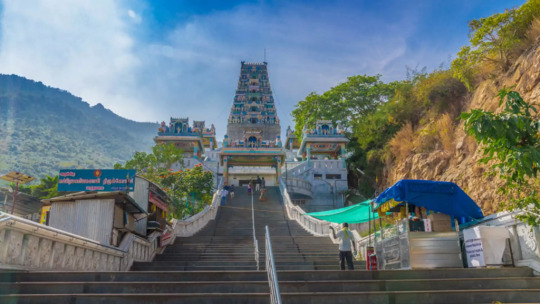
2. VOC Park and Zoo
Named after the freedom fighter V. O. Chidambaram Pillai, VOC Park and Zoo is a perfect spot for families. The park features a variety of recreational activities, including a toy train and a play area for children. The zoo, though small, houses an interesting collection of animals and birds, making it a delightful visit for kids and adults alike.

3. Perur Pateeswarar Temple
One of the oldest and most significant temples in Coimbatore, the Perur Pateeswarar Temple is dedicated to Lord Shiva. Known for its exquisite Dravidian architecture, intricate carvings, and historical significance, the temple is a spiritual haven for devotees and a marvel for architecture enthusiasts.

4. Gass Forest Museum
Located within the Forest College campus, the Gass Forest Museum offers a unique glimpse into the flora and fauna of the region. The museum, established in 1902, houses an extensive collection of taxidermy specimens, botanical samples, and artifacts related to forestry. It’s an educational and intriguing destination for nature lovers.
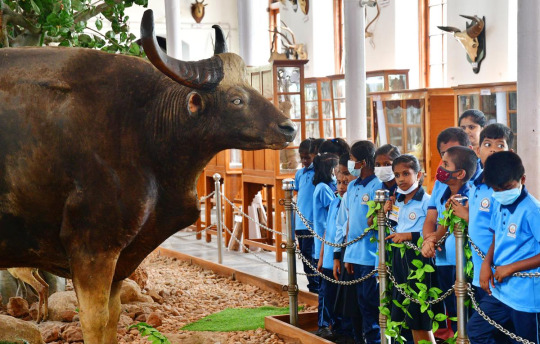
5. Brookefields Mall
For those who enjoy shopping and entertainment, Brookefields Mall is the place to be. This modern shopping complex features a wide range of retail outlets, eateries, and a multiplex cinema. It’s a great spot to relax, shop for souvenirs, and enjoy some leisure time.

6. Adiyogi Shiva Statue
A short drive from Coimbatore, the Adiyogi Shiva Statue at the Isha Yoga Center is a must-visit. Standing at 112 feet, this massive statue of Lord Shiva is not only a stunning piece of art but also a symbol of inner peace and well-being. The surrounding landscape and the tranquil atmosphere make it a perfect spot for meditation and reflection.
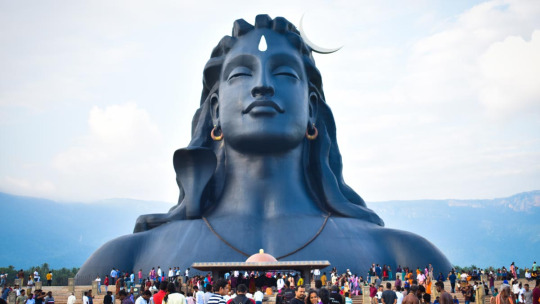
7. Siruvani Waterfalls and Dam
Located about 35 kilometers from Coimbatore, Siruvani Waterfalls and Dam are famous for their picturesque beauty and sweet-tasting water. The drive to the falls through lush green forests is an experience in itself. The serene environment and the cool waters of the falls provide a refreshing retreat from city life.
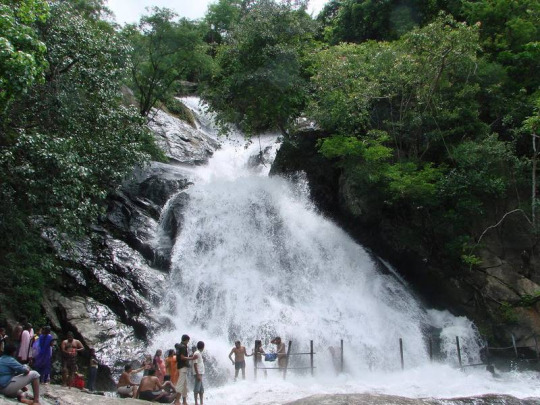
8. Eachanari Vinayagar Temple
This ancient temple, dedicated to Lord Ganesha, is one of the most visited religious sites in Coimbatore. The temple’s unique feature is its massive idol of Lord Ganesha, which stands at 6 feet tall and 3 feet wide. Devotees flock here to seek blessings and experience the temple’s serene ambiance.
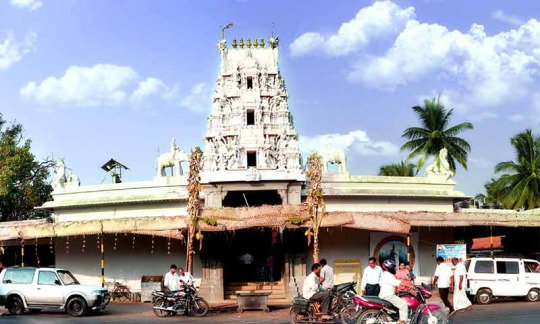
9. Tamil Nadu Agricultural University (TNAU) Botanical Garden
The botanical garden at TNAU is a verdant oasis in the heart of Coimbatore. Spread over 300 acres, the garden is home to a wide variety of plants, trees, and flowers. It’s a perfect spot for a leisurely stroll, a picnic, or simply to enjoy the beauty of nature.

10. Kovai Kutralam Falls
Also known as Kovai Courtallam, this waterfall is located in the Siruvani hills and is a popular tourist spot. The falls are surrounded by dense forests, and the area is well-maintained by the forest department. It’s an ideal place for a day trip, offering opportunities for trekking, photography, and relaxation by the cascading waters.

Conclusion
Coimbatore, with its rich cultural heritage, natural beauty, and modern amenities, has something to offer for everyone. Whether you’re a history buff, nature enthusiast, shopaholic, or spiritual seeker, this city will captivate you with its charm and diversity. So pack your bags and get ready to explore the myriad attractions of Coimbatore, a city that promises an unforgettable experience.
0 notes
Text
View my WhatsApp item
Follow this link to view our item on WhatsApp: https://wa.me/p/6612857332123712/918448425118
0 notes
Text
Lord Ganesha (Dwadasha) (12) names with meaning | What are the 12 names of Lord Ganesha mantra? - Let's know these divine names!
0 notes
Text
"Unveiling Lord Ganesh's Divine Essence: Exploring the 12 Main Names"
Explore the 12 main names of Lord Ganesh, from Ganesha to Dhumravarna, each symbolizing his wisdom, protection, and multifaceted attributes. Delve into the intricate meanings behind these names, revealing the profound influence of the beloved elephant-headed deity in Hinduism.
0 notes
Text
Original 5 mukhi nepali rudraksha with lab certified
Benefits of 5 mukhi rudraksha
5 Face (Mukhi) Rudraksha is named as Kalagni, who is Rudra himself. It is known as “all welfare, auspicious data and Ayushvardhak”. Its use blesses Lord Shiva in all spheres of life and signifies salvation, fulfillment of all desires and its admirers appear in the form of Pancha Brahma, (Ganesha, Shivam Shakti, Vishnu and Sun God) or Pancha Tattva Come
Who should wear five mukhi:-Those people who want good health, mental peace as well as high level of spirituality should wear 5 Mukhi Rudraksha. This Rudraksha is also beneficial for those who are suffering from diseases like blood pressure, diabetes and stomach ailments.
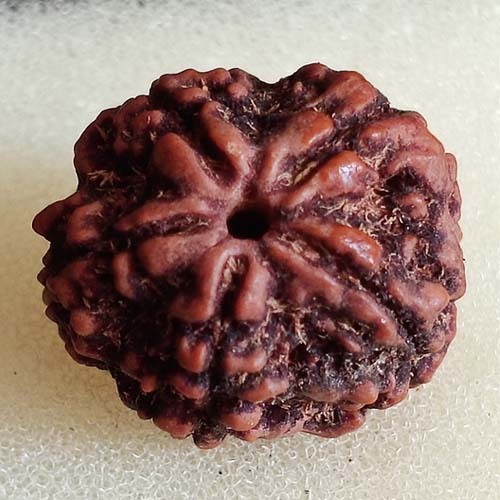
5 Mukhi Rudraksha :- Five Mukhi Rudraksha has 5 natural lines (mukhas) on its surface. The presiding deity of this 5 Mukhi Rudraksha is Lord “Kalagni” who is a form of Lord Shiva. It is the most commonly found Rudraksha and has the ability to destroy the “bad karma” of the present life
It helps in achieving success in all walks of life and gaining knowledge, wealth, power, fame and achieving goals. It is also often used in the treatment of many diseases. It is also very effective in eliminating your enemies. All the five Brahmas are pleased with the devotee who wears it. Lord Rudra also bestows success in all endeavors undertaken by the devotee. Diseases do not come to the person who wears it.
1 Mukhi Rudraksh
4 Mukhi Rudraksh
7 Mukhi Rudraksh
10 Mukhi Rudraksh
13 Mukhi Rudraksh
16 Mukhi Rudraksh
19 Mukhi Rudraksh
Ganesha Rudraksha
2 Mukhi Rudraksh
5 Mukhi Rudraksh
8 Mukhi Rudraksh
11 Mukhi Rudraksh
14 Mukhi Rudraksh
17 Mukhi Rudraksh
20 Mukhi Rudraksh
Gauri Shankar Rudraksha
3 Mukhi Rudraksh
6 Mukhi Rudraksh
9 Mukhi Rudraksh
12 Mukhi Rudraksh
15 Mukhi Rudraksh
18 Mukhi Rudraksh
21 Mukhi Rudraksh
Address-222, Agarwal tower, I.P.Extension, Patparganj, Delhi, 110092
Cont No. : 7042891757
0 notes
Text
Natural Rudaraksh, Navratna Original Gemstones Wholesaler.
Gauri Shankar Rudraksha is a type of Rudraksha bead that is considered to be one of the most powerful and auspicious beads among all the Rudrakshas. It is a rare type of Rudraksha that is formed naturally when two Rudraksha beads get joined together.
The Gauri Shankar Rudraksha is named after Lord Shiva (also known as Shankar) and his consort Goddess Parvati (also known as Gauri). It is believed to bring peace, harmony, and happiness in the life of the wearer by harmonizing the energies of the wearer and helping them to balance their mind, body, and soul.
It is also believed to be highly effective in spiritual practices like meditation, chanting, and other spiritual practices. The Gauri Shankar Rudraksha is said to represent the unity and harmony between Lord Shiva and Goddess Parvati and is considered to be a symbol of their divine union.
In Hindu mythology, it is believed that wearing the Gauri Shankar Rudraksha can help in removing obstacles and bringing good luck, prosperity, and success in the life of the wearer. It is also said to enhance spiritual growth and help in achieving enlightenment.

The Gauri Shankar Rudraksha is a rare and highly revered type of Rudraksha, which is a sacred bead used in Hinduism and Buddhism for spiritual and healing purposes. It is believed to have a variety of benefits, some of which are listed below:
1-Harmonizing relationships: The Gauri Shankar Rudraksha is associated with Lord Shiva and Goddess Parvati, and wearing it is said to help harmonize relationships between couples, family members, and business partners.
2-Enhancing spiritual growth: This Rudraksha is believed to activate the spiritual energy within the wearer, leading to heightened awareness, intuitive abilities, and spiritual growth.
3-Removing obstacles: The Gauri Shankar Rudraksha is said to help remove obstacles and barriers in one's life, paving the way for success, prosperity, and happiness.
4-Improving mental and emotional health: Wearing this Rudraksha is believed to help balance the mind and emotions, reducing stress, anxiety, and depression.
5-Promoting fertility: It is believed that the Gauri Shankar Rudraksha can help enhance fertility in women and men, leading to healthy conception and childbirth.
6-Enhancing creativity and intelligence: This Rudraksha is associated with the planet Jupiter, which is linked to creativity, intelligence, and knowledge. Wearing it is said to enhance these qualities and promote success in education, art, and intellectual pursuits.
1 Mukhi Rudraksh
4 Mukhi Rudraksh
7 Mukhi Rudraksh
10 Mukhi Rudraksh
13 Mukhi Rudraksh
16 Mukhi Rudraksh
19 Mukhi Rudraksh
Ganesha Rudraksha
2 Mukhi Rudraksh
5 Mukhi Rudraksh
8 Mukhi Rudraksh
11 Mukhi Rudraksh
14 Mukhi Rudraksh
17 Mukhi Rudraksh
20 Mukhi Rudraksh
Gauri Shankar Rudraksha
3 Mukhi Rudraksh
6 Mukhi Rudraksh
9 Mukhi Rudraksh
12 Mukhi Rudraksh
15 Mukhi Rudraksh
18 Mukhi Rudraksh
21 Mukhi Rudraksh
Ruby Gemstone
Emerald Gemstone
Cat's Eye Gemstone
Citrine Gemstone
Moonstone Gemstone
Spinel Gemstone
Hakik Gemstone
Peridot Gemstone
Blue Sapphire Gemstone
Pitambari | Neelambari Gemstone
Opal (दूधिया पत्थर)
Pink Sapphire Gemstone
Iolite Gemstone
Topaz Gemstone
Lapis Lazuli Gemstone
Onex Gemstone
Alexandrate
Turquoise
Yellow Sapphire Gemstone
White Sapphire Gemstone
Hessonite Gemstone
White Zircon Gemstone
Amethst Gemstone
Aquamarine Gemstone
Amber Gemstone
Tanzanite Gemstone
222, Agarwal tower, I.P.Extension, Patparganj, Delhi, 110092
Contact Number-7042891757
0 notes
Text
What Are The Different Shapes Of Pearls?

Introduction
What is Peridot?
Peridot is a gemstone that has been prized for thousands of years. It's a variety of the mineral olivine, which is also known as "chrysolite." Peridot's green color comes from iron content in its chemical composition and its name means "yellow-green" in Arabic.
Peridots are typically found in volcanic rock deposits throughout the world, but they're especially abundant in Arizona and Egypt--and those two locations account for most of what we find today! The largest peridot ever found was about 2 pounds (1 kilogram), but most specimens weigh between 1/2 ounce (14 grams) and 1 ounce (28 grams).
Peridots have been used since ancient times for jewelry making because they're beautiful gems with an interesting history behind them; however, their value depends on several factors including size and clarity as well as where they were mined from originally
What is Emerald?
Emerald is a green variety of the mineral beryl. It's also known as "beryl".
Emeralds are often confused with peridot because they're both green and have similar chemical compositions. However, emeralds are much more rare than peridots, which makes them more valuable. In fact, most emeralds are mined in Brazil or Colombia--and even then they're difficult to find!
Comparing Peridot and Emerald
Peridot and emerald are both beautiful gemstones that can be used in jewelry. They both have their own unique qualities, but it's important to know the differences between them before you make your purchase.
Here are some key points to consider:
Value:
Peridot is less expensive than emeralds because it's more abundant and easier to find. However, if you want a large piece of either stone or one that has exceptional clarity and color (which will increase its value), then it may cost more than an equivalent-sized emerald or peridot.
Rarity:
Emeralds are rarer than peridots on average because they're harder to find underground; however, this doesn't mean there aren't any deposits of these gems available today! You just need someone who knows where those deposits might be located so they can help guide you through the process of finding them yourself.
Quality:
The quality of any given piece depends on several factors including cut shape/size as well as clarity grade.
Instagram Gallery
4415
406
6472
66
4234
203
6138
918
9308
709
1799
179
4907
181
6304
199
3691
891
8835
38
7605
289
6754
881
2351
140
6065
999
1789
299
8435
636
7510
968
4754
896
Recent Posts
-
What to know before wearing a Garnet stone?
-
What is Blue Sapphire? Why Blue sapphire is the most Powerful Gemstone?
-
Can I wear Emerald stone (Panna) without consultation?
-
Unheated Ruby vs. Heated Ruby
Peridot For you
-
3.70 Carat Oval shape Natural Peridot Govt. Approved Lab GII India Certified
₹14,000.00 ₹7,400.00
-
4.40 Carat Oval shape Natural Peridot Govt. Approved Lab GII India Certified
₹12,000.00 ₹6,600.00
-
3.80 Carat Oval shape Natural Peridot Govt. Approved Lab GII India Certified
₹10,000.00 ₹5,700.00
Contact Us
FIND YOUR BEST STONE FROM BELOW COLLECTION
Blue Sapphire
Yellow Sapphire
Emerald
Ruby
Opal
Amethyst
Catseye
Blue Topaz
Yellow Topaz
Feroza
Garnet
Malachite
Pearl
Red Coral
Akik
White Coral
Peridot
Citrine
Aquamarine
Round CVD
Cushion CVD
Oval CVD
Princess CVD
Heart CVD
Emerald CVD
Radiant CVD
Asscher CVD
Baguette CVD
Pear CVD
Marquise CVD
Round HPHT
Cushion HPHT
Oval HPHT
Princess HPHT
Heart HPHT
Emerald HPHT
Radiant HPHT
Asscher HPHT
Baguette HPHT
Pear HPHT
Marquise HPHT
1 Mukhi
2 Mukhi
3 Mukhi
4 Mukhi
5 Mukhi
6 Mukhi
7 Mukhi
8 Mukhi
9 Mukhi
10 Mukhi
11 Mukhi
12 Mukhi
13 Mukhi
14 Mukhi
15 Mukhi
16 Mukhi
17 Mukhi
18 Mukhi
19 Mukhi
20 Mukhi
21 Mukhi
Gauri Shankar
Garbh Gauri Shankar
Savaar
Sidhha Mala
Jaap Mala
Indra Mala
Ganesha
Ganesha
Read the full article
0 notes
Text
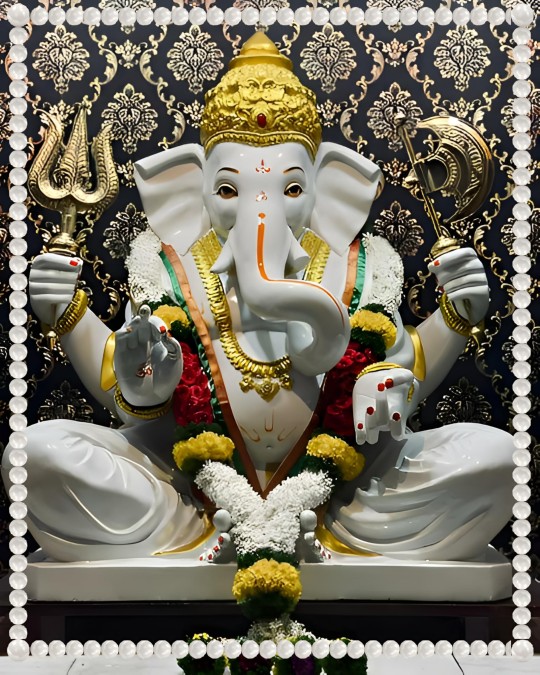
🙏 गणपती बाप्पा मोरया 🌺मंगलमूर्ती मोरया 🙏
🙏Ganapati Bappa Moraya 🌺 Mangalmurti Moraya 🙏28/01/2023
https://youtube.com/@haindavadharsanam
https://youtube.com/@entekeralammyindia
#haindavadharsanam #entekeralammyindia
Here are the 108 names of Lord Ganesha – 1. Gajanana - Om #Gajananaya Namah। 2. Ganadhyaksha - Om #Ganadhyakshaya Namah। 3. Vighnaraja -Om #Vighnarajaya Namah। 4. Vinayaka - Om #Vinayakaya Namah। 5. Dvaimatura -Om #Dvaimaturaya Namah। 6. Dwimukha - Om #Dwimukhaya Namah। 7. Pramukha - Om #Pramukhaya Namah। 8. Sumukha - Om #Sumukhaya Namah। 9. Kriti - Om #Kritine Namah। 10. Supradipa - Om #Supradipaya Namah। 11. Sukhanidhi - Om #Sukhanidhaye Namah। 12. Suradhyaksha - Om #Suradhyakshaya Namah। 13. Surarighna - Om #Surarighnaya Namah। 14. Mahaganapati - Om #Mahaganapataye Namah। 15. Manya - Om #Manyaya Namah। 16. Mahakala - Om #Mahakalaya Namah। 17. Mahabala -Om #Mahabalaya Namah। 18. Heramba - Om #Herambaya Namah। 19. Lambajathara - Om #Lambajatharayai Namah। 20. Haswagriva - Om #Haswa Grivaya Namah। 21. Mahodara - Om #Mahodaraya Namah। 22. Madotkata - Om #Madotkataya Namah। 23. Mahavira - Om #Mahaviraya Namah। 24. Mantrine - Om #Mantrine Namah। 25. Mangala Swara - Om #Mangala Swaraya Namah। 26. Pramadha - Om #Pramadhaya Namah। 27. Prathama - Om #Prathamaya Namah। 28. Prajna - Om #Prajnaya Namah। 29. Vighnakarta - Om #Vighnakartre Namah। 30. Vignaharta - Om #Vignahartre Namah। 31. Vishwanetra - Om #Vishwanetre Namah। 32. Viratpati - Om #Viratpataye Namah। 33.
।वक्रतुंड महाकाय सूर्यकोटि समप्रभ ।। ।।निर्विघ्नं कुरु मे देव सर्वकार्येषु सर्वदा ।। #entekeralammyindia #haindavadharsanam ¸.*♡*.¸ https://youtube.com/channel/UCmj1JCV_h_nqMeaMACR_c1Q
Shripati - Om #Shripataye Namah। 34. Vakpati - Om #Vakpataye Namah। 35. Shringarin - Om #Shringarine Namah। 36. Ashritavatsala - Om #Ashritavatsalaya Namah। 37. Shivapriya - Om #Shivapriyaya Namah। 38. Shighrakarina - Om #Shighrakarine Namah। 39. Shashwata - Om #Shashwataya Namah। 40. Bala - Om #Bala Namah। 41. Balotthitaya - Om #Balotthitaya Namah। 42. Bhavatmajaya - Om #Bhavatmajaya Namah। 43. Purana Purusha - Om #Purana #Purushaya Namah। 44. Pushne - #Om #Pushne #Namah। 45. Pushkarotshipta Varine - Om #Pushkarotshipta #Varine Namah। 46. Agraganyaya - Om #Agraganyaya Namah। 47. Agrapujyaya - Om #Agrapujyaya Namah। 48. Agragamine - Om #Agragamine Namah। 49. Mantrakrite - Om #Mantrakrite Namah। 50. Chamikaraprabhaya - Om #Chamikaraprabhaya Namah। 51. Sarvaya - Om #Sarvaya Namah। 52. Sarvopasyaya - Om #Sarvopasyaya Namah। 53. Sarvakartre - Om #Sarva #Kartre #Namah। 54. Sarvanetre - Om #Sarvanetre Namah। 55. Sarvasiddhipradaya - #Om #Sarvasiddhipradaya Namah। 56. Siddhaye - Om #Siddhaye Namah। 57. Panchahastaya - Om #Panchahastaya Namah। 58. Parvatinandanaya - Om #Parvatinandanaya Namah। 59. Prabhave - Om Prabhave Namah। 60. Kumaragurave - Om #Kumaragurave Namah। 61. Akshobhyaya - Om #Akshobhyaya Namah। 62. Kunjarasura Bhanjanaya - Om #Kunjarasura Bhanjanaya Namah। 63. Pramodaya - Om #Pramodaya Namah। 64. Modakapriyaya - Om #Modakapriyaya Namah। 65. Kantimate - Om #Kantimate Namah। 66. Dhritimate - Om #Dhritimate Namah। 67. Kamine - Om #Kamine Namah। 68. Kapitthapanasapriyaya - Om #Kapitthapanasapriyaya Namah। 69. Brahmacharine - Om #Brahmacharine Namah। 70. Brahmarupine - Om #Brahmarupine Namah। 71. Brahmavidyadi Danabhuve - Om #Brahmavidyadi Danabhuve Namah। 72. #Jishnave - Om #Jishnave Namah। 73. #Vishnupriyaya - Om Vishnupriyaya Namah। 74. #Bhakta Jivitaya - Om #Bhakta #Jivitaya Namah। 75 #Jitamanmadhaya - Om Jitamanmadhaya Namah। 76. #Aishwaryakaranaya - Om Aishwaryakaranaya Namah। 77. #Jyayase - Om Jyayase Namah। 78. #Yaksha Kinnerasevitaya - Om Yaksha Kinnerasevitaya Namah। 79. #Ganga Sutaya - Om Ganga Sutaya Namah। 80. #Ganadhishaya - Om Ganadhishaya Namah। 81. #Gambhira Ninadaya - Om Gambhira Ninadaya Namah। 82. #Vatave - Om Vatave Namah। 83. #Abhishtavaradaya - Om Abhishtavaradaya Namah। 84. #Jyotishe - Om Jyotishe Namah। 85. #Bhktanidhaye - Om Bhktanidhaye Namah। 86. #Bhavagamyaya - Om Bhavagamyaya Namah। 87. #Mangalapradaya - Om Mangalapradaya Namah। 88. #Avyaktaya - Om Avyaktaya Namah। 89. #Aprakrita Parakramaya - Om Aprakrita Parakramaya Namah। 90. #Satyadharmine - Om Satyadharmine Namah। 91. #Sakhaye - Om Sakhaye Namah। 92. #Sarasambunidhaye - Om Sarasambunidhaye Namah। 93. #Maheshaya - Om Maheshaya Namah। 94. #Divyangaya - Om Divyangaya Namah। 95. #Manikinkini Mekhalaya - Om Manikinkini Mekhalaya Namah। 96. #Samasta Devata Murtaye - Om Samasta Devata Murtaye Namah। 97. #Sahishnave - Om Sahishnave Namah। 98. #Satatotthitaya - Om Satatotthitaya Namah। 99. #Vighatakarine - Om Vighatakarine Namah। 100. #Vishwagdrishe - Om Vishwagdrishe Namah। 101. #Vishwarakshakrite -Om Vishwarakshakrite Namah। 102. #Kalyanagurave - Om Kalyanagurave Namah। 103. #Unmattaveshaya - Om Unmattaveshaya Namah। 104. #Aparajite - Om Aparajite Namah। 105. #Samsta Jagadadharaya - Om Samsta Jagadadharaya Namah। 106. #Sarwaishwaryapradaya - Om Sarwaishwaryapradaya Namah। 107. Akranta Chida #Chitprabhave - Om Akranta Chida Chitprabhave Namah। 108. Shri #Vighneshwaraya -Om Shri Vighneshwaraya Namah।
0 notes
Text
🍀 07, JANUARY 2023 SATURDAY ALL MESSAGES శనివారం, స్థిర వాసర సందేశాలు 🍀
🌹 🍀 07, JANUARY 2023 SATURDAY ALL MESSAGES శనివారం, స్థిర వాసర సందేశాలు 🍀🌹
1) 🌹 07, JANUARY 2023 SATURDAY, శనివారం, స్థిర వాసరే - నిత్య పంచాంగము Daily Panchangam🌹
2) 🌹 కపిల గీత - 115 / Kapila Gita - 115 🌹 సృష్టి తత్వము - 71
3) 🌹. విష్ణు సహస్ర నామ తత్వ విచారణ - 707 / Vishnu Sahasranama Contemplation - 707 🌹 🌻707. సుయామునః, सुयामुनः, Suyāmunaḥ🌻
4) 🌹 . శ్రీ శివ మహా పురాణము - 668 / Sri Siva Maha Purana - 668 🌹 🌻. గణాలకు అధిపతిగా పట్టాభిషేకం - గణేశుని వ్రత వర్ణనము - 6 / Gaṇeśa crowned as the chief of Gaṇas - Description of Ganesha Vrata - 6 🌻
5) 🌹 ఓషో రోజువారీ ధ్యానములు - 289 / Osho Daily Meditations - 289 🌹 🍀 289. మార్గదర్శి / THE GUIDE 🍀
6) 🌹. శ్రీ లలితా చైతన్య విజ్ఞానము - 422 - 4 / Sri Lalitha Chaitanya Vijnanam - 422 - 4 🌹 🌻 422. 'సంధ్యా' - 4 / 'Sandhya' - 4 🌻
🍀🌹🍀🌹🍀🌹🍀🌹🍀🌹
🍀🌹🍀🌹🍀🌹🍀🌹🍀🌹
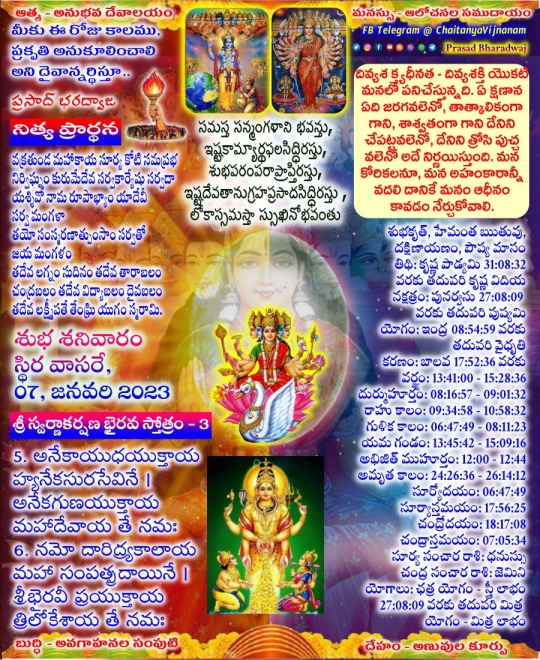
🌹07, జనవరి, January 2023 పంచాగము - Panchagam 🌹
శుభ శనివారం, Saturday, స్థిర వాసరే
మీకు ఈ రోజు కాలము, ప్రకృతి అనుకూలించాలి అని దైవాన్నర్థిస్తూ
ప్రసాద్ భరద్వాజ
🌻. పండుగలు మరియు పర్వదినాలు : లేవు🌻
🍀. శ్రీ స్వర్ణాకర్షణ భైరవ స్తోత్రం - 3 🍀
అనేకాయుధయుక్తాయ హ్యనేకసురసేవినే |
అనేకగుణయుక్తాయ మహాదేవాయ తే నమః
నమో దారిద్ర్యకాలాయ మహా సంపత్ప్రదాయినే |
శ్రీభైరవీ ప్రయుక్తాయ త్రిలోకేశాయ తే నమః
🌻 🌻 🌻 🌻 🌻
🍀. నేటి సూక్తి : దివ్యశ క్త్యధీనత - దివ్యశక్తి యొకటి మనలో పనిచేస్తున్నది. ఏ క్షణాన ఏది జరగవలెనో, తాత్కాలికంగా గాని, శాశ్వతంగా గాని దేనిని చేపట్టవలెనో, దేనిని త్రోసి పుచ్చవలెనో అదే నిర్ణయిస్తుంది. మన కోరికలనూ, మన అహంకారాన్నీ వదలి దానికే మనం ఆధీనం కావడం నేర్చుకోవాలి. 🍀
🌷🌷🌷🌷🌷
శుభకృత్, హేమంత ఋతువు,
దక్షిణాయణం, పౌష్య మాసం
తిథి: కృష్ణ పాడ్యమి 31:08:32
వరకు తదుపరి కృష్ణ విదియ
నక్షత్రం: పునర్వసు 27:08:09
వరకు తదుపరి పుష్యమి
యోగం: ఇంద్ర 08:54:59 వరకు
తదుపరి వైధృతి
కరణం: బాలవ 17:52:36 వరకు
వర్జ్యం: 13:41:00 - 15:28:36
దుర్ముహూర్తం: 08:16:57 - 09:01:32
రాహు కాలం: 09:34:58 - 10:58:32
గుళిక కాలం: 06:47:49 - 08:11:23
యమ గండం: 13:45:42 - 15:09:16
అభిజిత్ ముహూర్తం: 12:00 - 12:44
అమృత కాలం: 24:26:36 - 26:14:12
సూర్యోదయం: 06:47:49
సూర్యాస్తమయం: 17:56:25
చంద్రోదయం: 18:17:08
చంద్రాస్తమయం: 07:05:34
సూర్య సంచార రాశి: ధనుస్సు
చంద్ర సంచార రాశి: జెమిని
యోగాలు: ఛత్ర యోగం - స్త్రీ లాభం
27:08:09 వరకు తదుపరి మిత్ర
యోగం - మిత్ర లాభం
🌻 🌻 🌻 🌻 🌻
🍀. నిత్య ప్రార్థన 🍀
వక్రతుండ మహాకాయ సూర్యకోటి సమప్రభ
నిర్విఘ్నంకురుమేదేవ సర్వకార్యేషు సర్వదా
యశ్శివో నామ రూపాభ్యాం యాదేవీ సర్వ మంగళా
తయో సంస్మరణాత్పుంసాం సర్వతో జయ మంగళం
తదేవ లగ్నం సుదినం తదేవ తారాబలం చంద్రబలం తదేవ
విద్యాబలం దైవబలం తదేవ లక్ష్మీపతే తేంఘ్రి యుగం స్మరామి.
🌹🌹🌹🌹🌹
🍀🌹🍀🌹🍀🌹🍀🌹🍀🌹
🍀🌹🍀🌹🍀🌹🍀🌹🍀🌹

🌹. కపిల గీత - 115 / Kapila Gita - 115🌹
🍀. కపిల దేవహూతి సంవాదం 🍀
✍️. శ్రీమాన్ క.రామానుజాచార్యులు, 📚. ప్రసాద్ భరధ్వాజ
🌴 2. సృష్టి తత్వము - ప్రాథమిక సూత్రాలు - 71 🌴
71. యథా ప్రసుప్తం పురుషం ప్రాణేంద్రియమనో ధియః|
ప్రభవంతి వినా యేన నోత్థాపయితుమోజసా॥
నిద్ర పోవుచున్న మనిషిని క్షేత్రజ్ఞుడు లేకుండా ప్రాణము, ఇంద్రియములు, మనస్సు, బుద్ధి మొదలగునవి తమ బలముచే మేలుకొల్ప జాలవు. ఇట్లే ఆయా ఇంద్రియముల అధిష్ఠాన దేవతలు ఎవరునూ తమ విరాట్పురుషుని లేప జాలక పోయిరి.
సాంఖ్య తత్వశాస్త్రం యొక్క వివరణ ఇక్కడ వివరంగా వివరించబడింది, విరాట్-పురుషుడు, లేదా భగవంతుని యొక్క సార్వత్రిక రూపం, అన్ని వివిధ ఇంద్రియ అవయవాలు మరియు వాటి అధిపతి దేవతలకు అసలు మూలం. విరాట్-పురుషుడు మరియు దేవతలు లేదా జీవుల మధ్య సంబంధం చాలా క్లిష్టంగా ఉంటుంది. కేవలం వారి అధిష్టాన దేవతలకు సంబంధించిన ఇంద్రియ అవయవాలను వ్యాయామం చేయడం ద్వారా, విరాట్-పురుషుడు ఉద్భవించ లేరు. భౌతిక కార్యకలాపాల ద్వారా విరాట్-పురుషుడిని ప్రేరేపించడం ద్వారా పరమాత్మ యొక్క పరమ సంపూర్ణత్వంతో అనుసంధానం చేయడం సాధ్యం కాదు. భక్తితో కూడిన సేవ మరియు నిర్లిప్తత ద్వారా మాత్రమే సంపూర్ణతతో అనుసంధానించే ప్రక్రియను నిర్వహించగలరు.
సశేషం..
🌹 🌹 🌹 🌹 🌹
🌹 Kapila Gita - 115 🌹
🍀 Conversation of Kapila and Devahuti 🍀
📚 Prasad Bharadwaj
🌴 2. Fundamental Principles of Material Nature - 71 🌴
71. yathā prasuptaṁ puruṣaṁ prāṇendriya-mano-dhiyaḥ
prabhavanti vinā yena notthāpayitum ojasā
When a man is sleeping, all his material assets—namely the vital energy, the senses for recording knowledge, the senses for working, the mind and the intelligence—cannot arouse him. He can be aroused only when the Supersoul helps him.
The explanation of Sāṅkhya philosophy is described here in detail in the sense that the virāṭ-puruṣa, or the universal form of the Supreme Personality of Godhead, is the original source of all the various sense organs and their presiding deities. The relationship between the virāṭ-puruṣa and the presiding deities or the living entities is so intricate that simply by exercising the sense organs, which are related to their presiding deities, the virāṭ-puruṣa cannot be aroused. It is not possible to arouse the virāṭ-puruṣa or to link with the Supreme Absolute Personality of Godhead by material activities. Only by devotional service and detachment can one perform the process of linking with the Absolute.
Continues…
🌹 🌹 🌹 🌹 🌹
🍀🌹🍀🌹🍀🌹🍀🌹🍀🌹
🍀🌹🍀🌹🍀🌹🍀🌹🍀🌹
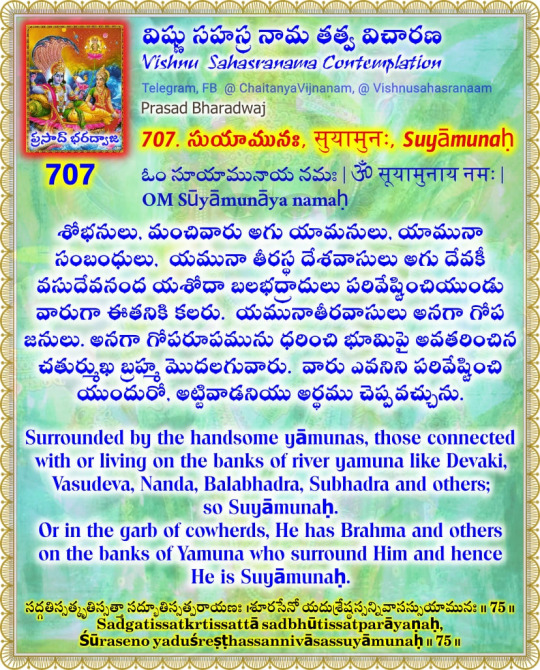
🌹. విష్ణు సహస్ర నామ తత్వ విచారణ - 707 / Vishnu Sahasranama Contemplation - 707🌹
🌻707. సుయామునః, सुयामुनः, Suyāmunaḥ🌻
ఓం సూయామునాయ నమః | ॐ सूयामुनाय नमः | OM Sūyāmunāya namaḥ
శోభనా యామునా యస్య యమునాతీరవాసినః ।
యశోదాదేవకీనన్ద వసుదేవాదయో హరిః ॥
పరివేష్టార ఇతి స సుయామున ఇతీర్యతే ।
యామునాః పరివేష్టారో గోపవేషధరా హరేః ॥
పద్మాసనాదయో యస్య శోభనాస్సన్తి హరేః ॥
పద్మాసనాదయో యస్య శోభనాస్సన్తి స ప్రభుః ।
సుయామున ఇతి ప్రోక్తః పురాణార్థ విశారదైః ॥
శోభనులు, మంచివారు అగు యామనులు, యామునా సంబంధులు, యమునా తీరస్థ దేశవాసులు అగు దేవకీ వసుదేవ నంద యశోదా బలభద్రాదులు పరివేష్టించి యుండు వారుగా ఈతనికి కలరు. యమునా తీరవాసులు అనగా గోప జనులు. అనగా గోప రూపమును ధరించి భూమిపై అవతరించిన చతుర్ముఖ బ్రహ్మ మొదలగు వారు. వారు ఎవనిని పరివేష్టించి యుందురో, అట్టి వాడనియు అర్థము చెప్పవచ్చును.
సశేషం…
🌹 🌹 🌹 🌹 🌹
🌹. VISHNU SAHASRANAMA CONTEMPLATION- 707🌹
🌻707. Suyāmunaḥ🌻
OM Sūyāmunāya namaḥ
शोभना यामुना यस्य यमुनातीरवासिनः ।
यशोदादेवकीनन्द वसुदेवादयो हरिः ॥
परिवेष्टार इति स सुयामुन इतीर्यते ।
यामुनाः परिवेष्टारो गोपवेषधरा हरेः ॥
पद्मासनादयो यस्य शोभनास्सन्ति हरेः ॥
पद्मासनादयो यस्य शोभनास्सन्ति स प्रभुः ।
सुयामुन इति प्रोक्तः पुराणार्थ विशारदैः ॥
Śobhanā yāmunā yasya yamunātīravāsinaḥ,
Yaśodādevakīnanda vasudevādayo hariḥ.
Pariveṣṭāra iti sa suyāmuna itīryate,
Yāmunāḥ pariveṣṭāro gopaveṣadharā hareḥ.
Padmāsanādayo yasya śobhanāssanti hareḥ.
Padmāsanādayo yasya śobhanāssanti sa prabhuḥ,
Suyāmuna iti proktaḥ purāṇārtha viśāradaiḥ.
Surrounded by the handsome yāmunas, those connected with or living on the banks of river yamuna like Devaki, Vasudeva, Nanda, Balabhadra, Subhadra and others; so Suyāmunaḥ.
Or in the garb of cowherds, He has Brahma and others on the banks of Yamuna who surround Him and hence He is Suyāmunaḥ.
🌻 🌻 🌻 🌻 🌻
Source Sloka
सद्गतिस्सत्कृतिस्सत्ता सद्भूतिस्सत्परायणः ।शूरसेनो यदुश्रेष्ठस्सन्निवासस्सुयामुनः ॥ ७५ ॥
సద్గతిస్సత్కృతిస్సత్తా సద్భూతిస్సత్పరాయణః ।శూరసేనో యదుశ్రేష్ఠస్సన్నివాసస్సుయామునః ॥ 75 ॥
Sadgatissatkrtissattā sadbhūtissatparāyaṇaḥ,Śūraseno yaduśreṣṭhassannivāsassuyāmunaḥ ॥ 75 ॥
Continues….
🌹 🌹 🌹 🌹🌹
🍀🌹🍀🌹🍀🌹🍀🌹🍀🌹
🍀🌹🍀🌹🍀🌹🍀🌹🍀🌹
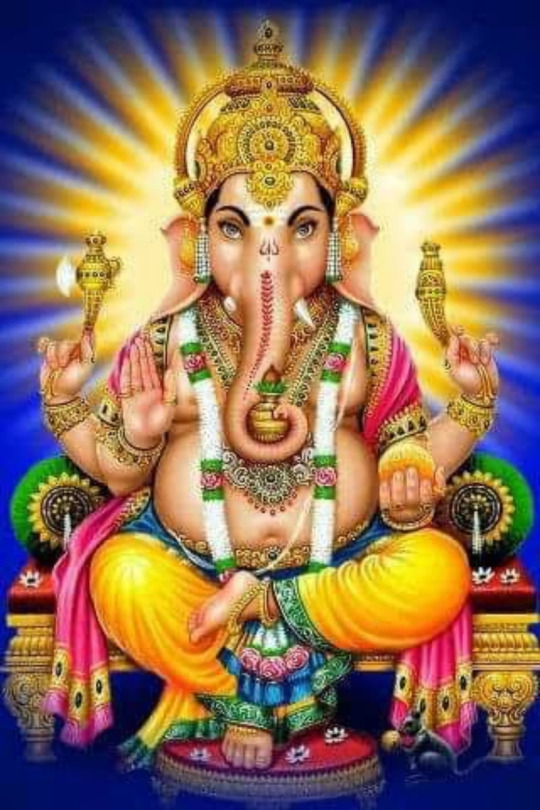
🌹 . శ్రీ శివ మహా పురాణము - 668 / Sri Siva Maha Purana - 668 🌹
✍️. స్వామి తత్త్వ విదానంద సరస్వతి 📚. ప్రసాద్ భరద్వాజ
🌴. రుద్రసంహితా-కుమార ఖండః - అధ్యాయము - 18 🌴
🌻. గణాలకు అధిపతిగా పట్టాభిషేకం - గణేశుని వ్రత వర్ణనము - 6 🌻
ఉపవాసముండి దూర్వలతో పూజించవలెను. రాత్రి యొక్క మొదటి యామము నందు స్నానముచేసి మానవుడు పూజించవలెను (41). లోహమూర్తిని గాని, పగడముల మూర్తిని గాని, తెల్ల జిల్లెడుతో చేసిన మూర్తిని గతాని, మట్టితో చేసిన మూర్తిని గాని పూజించవలెను (42). మానవుడు అట్టి మూర్తిని ప్రతిష్ఠించి నానావిధములగు దివ్యచందనముతో మరియు సుగంధ ద్రవ్యములతో, పుష్పములతో శ్రద్ధగా పూజించవలెను (43). దూర్వలు పన్నెండు అంగుళముల పొడవు గలవై వ్రేళ్లు లేనివిగా ఉండవలెను. వాటికి ఉపాంగములు ఉండరాదు. దూర్వలు గట్టిగా నుండవలెను. నూట ఒక్క దూర్వాలతో ఆ ప్రతిమను పూజించవలెను (44).
గణనాయకుని ప్రతిమను ఇరవై ఒక్క పత్రములతో పూజించి ధూపదీపములను, వివిధ నైవేద్యములను సమర్పించవలెను (45). ఆ ప్రతిమయందు నిన్ను ఈ విధముగా తాంబూలముతో, పవిత్ర పూజాద్రవ్యములతో పూజించి ప్రణమిల్లి స్తుతించి బాలచంద్రుని కూడా పూజించవలెను (46). తరువాత బ్రాహ్మణులను చక్కగా పూజించి, మధుర పదార్ధములతో ఆనందముగా భోజనము నిడవలెను. తరువాత తాను కూడా ఉప్పులేని మధురమగు ఆహారమును భుజించవలెను (47). తరువాత వ్రత నియముములనన్నిటినీ విడిచి పెట్టి గణేశుని స్మరించినచో, ఈ శుభవ్రతము పూర్తియగును (48).
సశేషం….
🌹 🌹 🌹 🌹 🌹
🌹 SRI SIVA MAHA PURANA - 668🌹
*✍️ J.L. SHASTRI, 📚. Prasad Bharadwaj *
🌴 Rudra-saṃhitā (4): Kumara-khaṇḍa - CHAPTER 18 🌴
🌻 Gaṇeśa crowned as the chief of Gaṇas - Description of Ganesha Vrata - 6 🌻
He shall perform worship with the Dūrvā grass and observe fast. After a Prahara has elapsed in the night the devotee shall take bath and worship.
42-43. The idol shall be made of metal, coral, white Arka flowers or clay. It shall be installed and worshipped by the devotee with all purity, with scents of various kinds, divine sandal paste and flowers.
44-45. A handful of Dūrvā grass having three knots and without roots shall be used for worship. The shoots shall be hundred and one in number. With twentyone the idol shall be worshipped. Gaṇeśa shall be adored with incense, lamps and different kinds of food-offerings.
After worshipping you with various articles of worship like betel etc. and eulogising you with hymns, the devotee shall worship the crescent moon.
Afterwards, he shall feed the brahmins joyously with sweets with due honour. He himself shall take sweets and avoid salt.
Then the rites shall formally be dismissed. Then he shall remember Gaṇeśa. Thus the Vrata shall be concluded auspiciously.
Continues….
🌹🌹🌹🌹🌹
🍀🌹🍀🌹🍀🌹🍀🌹🍀🌹
🍀🌹🍀🌹🍀🌹🍀🌹🍀🌹
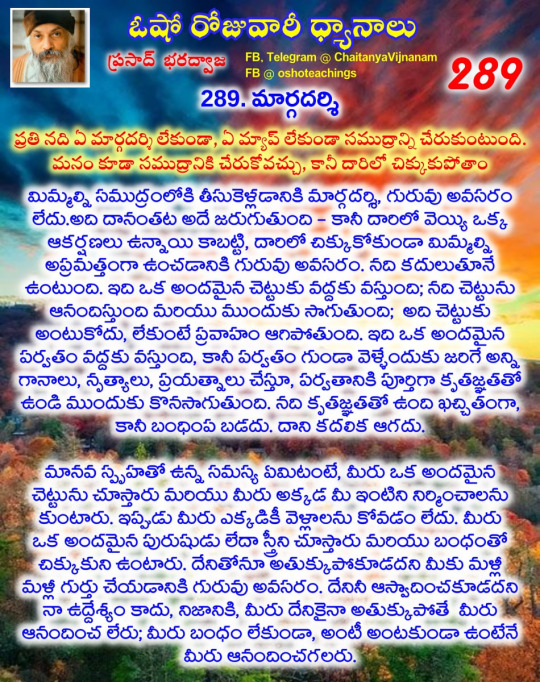
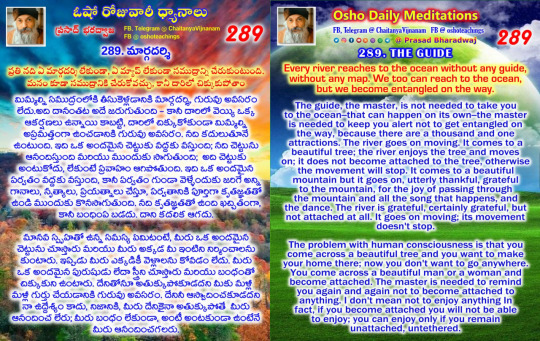
🌹. ఓషో రోజువారీ ధ్యానాలు - 289 / Osho Daily Meditations - 289 🌹
✍️. ప్రసాద్ భరద్వాజ
🍀 289. మార్గదర్శి 🍀
🕉. ప్రతి నది ఏ మార్గదర్శి లేకుండా, ఏ మ్యాప్ లేకుండా సముద్రాన్ని చేరుకుంటుంది. మనం కూడా సముద్రానికి చేరుకోవచ్చు, కానీ దారిలో చిక్కుకుపోతాం. 🕉
మిమ్మల్ని సముద్రంలోకి తీసుకెళ్లడానికి మార్గదర్శి, గురువు అవసరం లేదు - అది దానంతట అదే జరుగుతుంది - కానీ దారిలో వెయ్యి ఒక్క ఆకర్షణలు ఉన్నాయి కాబట్టి, దారిలో చిక్కుకోకుండా మిమ్మల్ని అప్రమత్తంగా ఉంచడానికి గురువు అవసరం. నది కదులుతూనే ఉంటుంది. ఇది ఒక అందమైన చెట్టుకు వద్దకు వస్తుంది; నది చెట్టును ఆనందిస్తుంది మరియు ముందుకు సాగుతుంది; అది చెట్టుకు అంటుకోదు, లేకుంటే ప్రవాహం ఆగిపోతుంది. ఇది ఒక అందమైన పర్వతం వద్దకు వస్తుంది, కానీ పర్వతం గుండా వెళ్ళేందుకు జరిగే అన్ని గానాలు, నృత్యాలు, ప్రయత్నాలు చేస్తూ, పర్వతానికి పూర్తిగా కృతజ్ఞతతో ఉండి ముందుకు కొనసాగుతుంది. నది కృతజ్ఞతతో ఉంది ఖచ్చితంగా, కానీ బంధింప బడదు. దాని కదలిక ఆగదు.
మానవ స్పృహతో ఉన్న సమస్య ఏమిటంటే, మీరు ఒక అందమైన చెట్టును చూస్తారు మరియు మీరు అక్కడ మీ ఇంటిని నిర్మించాలను కుంటారు. ఇప్పుడు మీరు ఎక్కడికీ వెళ్లాలను కోవడం లేదు. మీరు ఒక అందమైన పురుషుడు లేదా స్త్రీని చూస్తారు మరియు బంధంతో చిక్కుకుని ఉంటారు. దేనితోనూ అతుక్కుపోకూడదని మీకు మళ్లీ మళ్లీ గుర్తు చేయడానికి గురువు అవసరం. దేనినీ ఆస్వాదించకూడదని నా ఉద్దేశ్యం కాదు, నిజానికి, మీరు దేనికైనా అతుక్కుపోతే మీరు ఆనందించ లేరు; మీరు బంధం లేకుండా, అంటకుండా ఉంటేనే మీరు ఆనందించగలరు.
కొనసాగుతుంది…
🌹 🌹 🌹 🌹 🌹

🌹 Osho Daily Meditations - 289 🌹
📚. Prasad Bharadwaj
🍀 289. THE GUIDE 🍀
🕉. Every river reaches to the ocean without any guide, without any map. We too can reach to the ocean, but we become entangled on the way. 🕉
The guide, the master, is not needed to take you to the ocean--that can happen on its own--the master is needed to keep you alert not to get entangled on the way, because there are a thousand and one attractions. The river goes on moving. It comes to a beautiful tree; the river enjoys the tree and moves on; it does not become attached to the tree, otherwise the movement will stop. It comes to a beautiful mountain but it goes on, utterly thankful, grateful to the mountain, for the joy of passing through the mountain and all the song that happens, and the dance. The river is grateful, certainly grateful, but not attached at all. It goes on moving; its movement doesn't stop.
The problem with human consciousness is that you come across a beautiful tree and you want to make your home there; now you don't want to go anywhere. You come across a beautiful man or a woman and become attached. The master is needed to remind you again and again not to become attached to anything. I don't mean not to enjoy anything In fact, if you become attached you will not be able to enjoy; you can enjoy only if you remain unattached, untethered.
Continues…
🌹 🌹 🌹 🌹 🌹
🍀🌹🍀🌹🍀🌹🍀🌹🍀🌹
🍀🌹🍀🌹🍀🌹🍀🌹🍀🌹
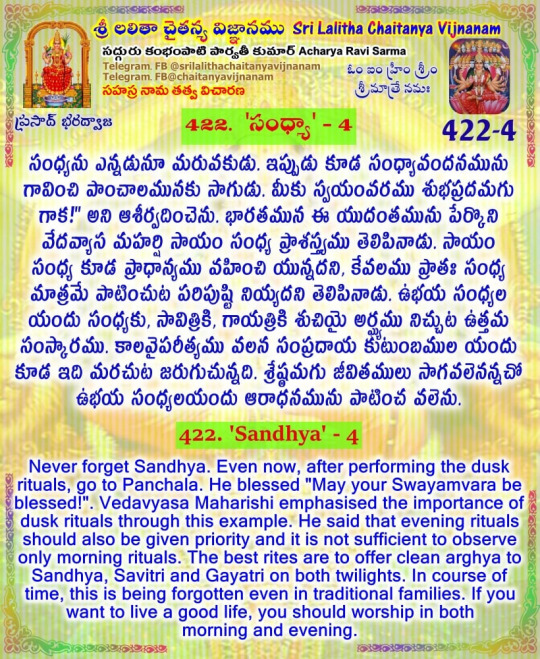
🌹. శ్రీ లలితా చైతన్య విజ్ఞానము - 422 - 4 / Sri Lalitha Chaitanya Vijnanam - 422 - 4 🌹
🌻. లలితా సహస్ర నామముల తత్వ విచారణ 🌻
✍️. సద్గురు శ్రీ కంభంపాటి పార్వతీ కుమార్
సేకరణ : ప్రసాద్ భరద్వాజ
🍁. మూల మంత్రము : ఓం ఐం హ్రీం శ్రీం శ్రీమాత్రే నమః 🍁
🍀 90. చిచ్ఛక్తి, శ్చేతనారూపా, జడశక్తి, ర్జడాత్మికా ।
గాయత్రీ, వ్యాహృతి, స్సంధ్యా, ద్విజబృంద నిషేవితా ॥ 90 ॥ 🍀
🌻 422. 'సంధ్యా' - 4🌻
సంధ్యను ఎన్నడునూ మరువకుడు. ఇప్పుడు కూడ సంధ్యావందనమును గావించి పాంచాలమునకు సాగుడు. మీకు స్వయంవరము శుభప్రదమగుగాక!" అని ఆశీర్వదించెను. భారతమున ఈ యుదంతమును పేర్కొని వేదవ్యాస మహర్షి సాయం సంధ్య ప్రాశస్త్యము తెలిపినాడు. ��ాయం సంధ్య కూడ ప్రాధాన్యము వహించి యున్నదని, కేవలము ప్రాతః సంధ్య మాత్రమే పాటించుట పరిపుష్టి నియ్యదని తెలిపినాడు. ఉభయ సంధ్యల యందు సంధ్యకు, సావిత్రికి, గాయత్రికి శుచియై అర్ఘ్యము నిచ్చుట ఉత్తమ సంస్కారము. కాలవైపరీత్యము వలన సంప్రదాయ కుటుంబముల యందు కూడ ఇది మరచుట జరుగుచున్నది. శ్రేష్ఠమగు జీవితములు సాగవలెనన్నచో ఉభయ సంధ్యలయందు ఆరాధనమును పాటించ వలెను.
సశేషం…
🌹 🌹 🌹 🌹 🌹
🌹 Sri Lalitha Chaitanya Vijnanam - 422 - 4 🌹
Contemplation of 1000 Names of Sri Lalitha Devi
✍️ Prasad Bharadwaj
🌻 90. Chichakti shchetanarupa jadashakti jadatmika
Gayatri vyahruti sandhya dvijabrunda nishemita ॥ 90 ॥🌻
🌻 422. 'Sandhya' - 4🌻
Never forget Sandhya. Even now, after performing the dusk rituals, go to Panchala. He blessed "May your Swayamvara be blessed!". Vedavyasa Maharishi emphasised the importance of dusk rituals through this example. He said that evening rituals should also be given priority and it is not sufficient to observe only morning rituals. The best rites are to offer clean arghya to Sandhya, Savitri and Gayatri on both twilights. In course of time, this is being forgotten even in traditional families. If you want to live a good life, you should worship in both morning and evening.
Continues…
🌹 🌹 🌹 🌹 🌹
🍀🌹🍀🌹🍀🌹🍀🌹🍀🌹
🍀🌹🍀🌹🍀🌹🍀🌹🍀🌹
0 notes
Photo

Matrikas (Sanskrit: मातृका (singular), IAST: mātṝkās, lit. "divine mothers")[2] also called Matar or Matri, are a group of mother goddesses who are always depicted together in Hinduism. The Matrikas are often depicted in a group of seven, the Saptamatrika(s) (Seven Mothers).[3] However, they are also depicted as a group of eight, the Ashtamatrika(s).[4]
In the Brihat Samhita, Varahamihira says that "Mothers are to be made with cognizance of (different major Hindu) gods corresponding to their names."[5] They are associated with these gods as their spouses or their energies (Shaktis).[6]Brahmani emerged from Brahma, Vaishnavi from Vishnu, Maheshvari from Shiva, Indrani from Indra, Kaumari from Skanda, Varahi from Varaha and Chamunda from Devi.[7] and additionals are Narasimhi and Vinayaki from Ganesha.
Originally believed to be a personification of the seven stars of the star cluster the Pleiades, they became quite popular by the seventh century and a standard feature of goddess temples from the ninth century onwards.[8] In South India, Saptamatrika worship is prevalent whereas the Ashtamatrika are venerated in Nepal, among other places.[9]
The Matrikas assume paramount significance in the goddess-oriented sect of Hinduism, Tantrism.[10] In Shaktism, they are described as "assisting the great Shakta Devi (goddess) in her fight with demons."[11] Some scholars consider them Shaiva goddesses.[12] They are also connected with the worship of warrior god Skanda.[13] In most early references, the Matrikas are associated with the conception, birth, diseases and protection of children.[14] They were seen as inauspicious[15] and the "personification of perils", propitiated in order to avoid those ills, that carried off so many children before they reached adulthood.[14] They come to play a protective role in later mythology, although some of their early inauspicious and wild characteristics continue in these legends.[15] Thus, they represent the prodigiously fecund aspect of nature as well as its destructive force aspect.
https://en.wikipedia.org/wiki/Matrikas
1 note
·
View note